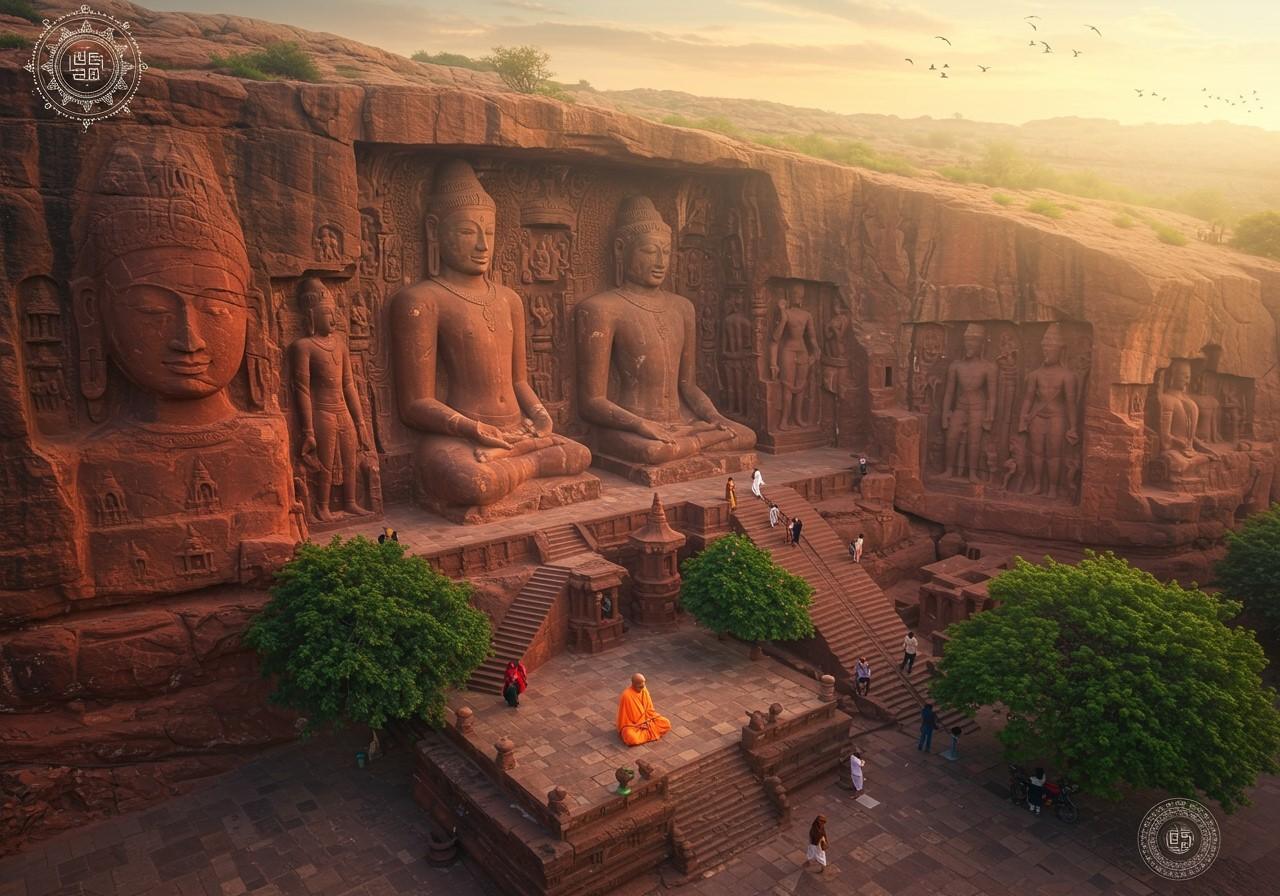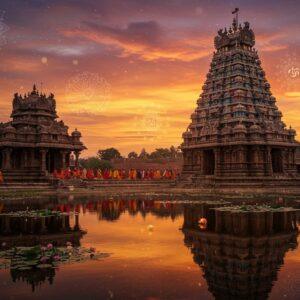
Nestled amidst the captivating landscapes of Madhya Pradesh, the Siddhachal Caves beckon travelers on a profound spiritual quest. These ancient caves, etched into the rugged terrain, stand as a testament to Jain devotion, artistic brilliance, and India’s rich cultural tapestry. Delving into their historical and architectural significance unveils a deeper appreciation for this sacred site.
Unveiling the Historical Significance
The Siddhachal Caves, also known as the Gopachal Caves, trace their origins back to the 15th century during the Tomar Dynasty’s reign. Serving as a sanctuary for Jain devotees, these caves showcase intricate carvings and sculptures that depict Tirthankaras, revered figures in Jainism. These artistic expressions not only narrate religious stories but also reflect the aesthetic sensibilities influenced by Jain philosophy, underscoring the caves’ profound historical importance within Indian culture.
The caves form a part of a larger complex of nearly 100 Jain rock carvings scattered throughout Gwalior, with Siddhachal being a prominent and frequently visited site. A significant event in their history is the defacement and desecration they endured in 1527 under Emperor Babur’s rule, a testament to the tumultuous times they’ve witnessed.
Architectural Marvels: A Symphony in Stone
The Siddhachal Caves, nestled within the formidable Gwalior Fort, are a testament to the artistry and dedication of ancient artisans. These rock-cut monuments feature colossal carvings of Jain Tirthankaras, including the awe-inspiring 47-foot idol of Parshvanatha. The meticulous detail and sheer scale of these sculptures create a powerful spiritual aura, captivating visitors with their grandeur and grace.
The artisans’ skillful use of chisels to etch detailed reliefs and ornate facades showcases the profound influence of Jain artistic traditions. Each statue, such as that of Lord Adinath, holds deep spiritual meaning, embodying the core values and teachings of Jainism.
Cultural and Religious Practices: A Tapestry of Devotion
Today, the Siddhachal Caves continue to serve as a vital spiritual hub for Jain devotees. Pilgrims flock to these sacred grounds to partake in rituals, ceremonies, meditation, and prayer, finding solace and connection with their faith. The tranquil atmosphere fosters introspection and a deeper understanding of Jain principles.
Local communities play an active role in preserving the sanctity and structural integrity of these caves. Their dedication to cultural awareness and heritage conservation ensures that the historical importance of this site endures for generations to come.
Planning Your Visit: A Practical Guide
A visit to the Siddhachal Caves promises a deeply enriching experience. The ideal time to embark on this journey is during the cooler months (October to March) or during religious festivals when the atmosphere is particularly vibrant. Gwalior is easily accessible by train and road, offering convenient travel options for all visitors.
Guided tours provide valuable insights into the caves’ history and significance, while nearby accommodations offer comfortable retreats for those seeking a more immersive spiritual experience. Information centers at the site further enhance understanding and appreciation of this sacred destination.
Exploring Gwalior: Beyond the Caves
Gwalior’s cultural riches extend beyond the Siddhachal Caves. The majestic Gwalior Fort, standing proudly 100 meters above the town, is an architectural marvel in itself. Other nearby attractions, such as the opulent Jai Vilas Palace, contribute to the city’s rich tapestry of historical and cultural landmarks.
Experiencing traditional music performances and savoring the flavors of regional cuisine offer a glimpse into the vibrant local culture, creating a truly memorable and multifaceted travel experience. This harmonious blend of history, spirituality, and cultural immersion makes Gwalior a truly compelling destination.
Poojn.in: Your Companion on the Spiritual Path
Poojn.in, India’s leading online store for cultural and religious goods, offers a curated selection of essential items for Jain devotees embarking on a pilgrimage to the Siddhachal Caves. We provide authentic puja items that align with Jain traditions and rituals, ensuring a meaningful and spiritually fulfilling experience.
-
Pure Cotton Vastras: Traditional white cotton attire, perfect for temple visits and meditation within the serene cave premises. Our vastras are made from high-quality cotton, ensuring comfort and purity during your spiritual practices.
-
Meditation Mats: Comfortable asanas designed to support your meditation practice, allowing you to find peace and tranquility within the sacred space of the caves. Our mats are crafted with natural materials for a grounding and supportive experience.
-
Pure Ghee Diyas: Traditional oil lamps for aarti ceremonies, crafted with pure ghee to enhance the spiritual ambiance and illuminate your devotion. We offer a variety of diya designs to suit your preferences.
-
Incense Sticks: A selection of pure sandalwood and natural fragrance incense sticks to create a serene and uplifting atmosphere during your prayers and meditation. Our incense is made with natural ingredients, free from harmful chemicals.
-
Dry Fruits and Nuts: Fresh, premium-quality offerings for the temple, carefully selected and packaged to maintain their freshness and purity. We source our dry fruits and nuts from trusted suppliers, ensuring the highest quality for your offerings.
-
Prayer Beads: Traditional malas crafted from various materials, ideal for japa and meditation practices. Our malas are designed to aid in focus and concentration during your spiritual exercises.
All items are carefully chosen to adhere to Jain dietary and religious guidelines. We ensure contactless delivery across India with secure packaging to preserve the purity of these sacred products. Our commitment to quality is reflected in our quality assurance and authentic sourcing certificates. Visit www.poojn.in or contact our customer service for specific Jain ritual items. We also offer bulk ordering options for group pilgrimages to the Siddhachal Caves.
You can also explore our range of Radha Krishna bigrahas here and marble dust Laxmi Ganesh murtis here.
Conclusion: Embrace the Spiritual Awakening
The Siddhachal Jain Caves offer more than just an architectural spectacle; they provide a gateway to India’s profound spiritual and cultural heritage. As you traverse these sacred halls, the timeless carvings and serene ambiance evoke a sense of reverence and introspection. The caves stand as a powerful symbol of devotion and artistry, echoing the enduring values and teachings of Jainism.
A visit to the Siddhachal Caves is a transformative spiritual experience, connecting you with centuries of tradition. As you explore the vibrant city of Gwalior, its rich history and culture unfold, adding layers of meaning to your journey. Whether you seek spiritual solace or a deeper understanding of India’s architectural wonders, the Siddhachal Caves promise an unforgettable experience filled with awe and inspiration. Embrace this opportunity to connect with India’s past and create memories that will resonate long after your visit.
FAQs: Your Guide to Siddhachal Caves
What are Siddhachal Caves? The Siddhachal Caves, also known as Gopachal Caves, are a series of ancient Jain rock-cut caves located within the Gwalior Fort complex in Madhya Pradesh, India. They are renowned for their intricate carvings and spiritual significance within the Jain tradition.
Where are they located? The Siddhachal Caves are situated within the Gwalior Fort, a prominent historical landmark in Gwalior, Madhya Pradesh, India.
When is the best time to visit? The most pleasant time to visit is during the cooler months, from October to March, when the weather is ideal for exploration.
Why are they important? The Siddhachal Caves hold deep religious significance for the Jain community, showcasing ancient Jain art and serving as a symbol of spiritual devotion. They represent a significant part of India’s cultural and artistic heritage.
How can I reach them? The caves are easily accessible from Gwalior’s railway station and bus stand via taxi or auto-rickshaw. The fort and caves are well-connected by road.
Are there entry fees? There is typically a nominal entry fee for the caves. It is advisable to check the latest fee information before your visit.
What should I wear? Modest and comfortable clothing is recommended. Shoes that are easy to remove are suggested, as you may need to enter religious areas barefoot.
Is photography allowed? Photography is generally permitted, but confirming any restrictions at the entrance is always a good practice. Respect the religious sanctity of the site while taking photographs.


